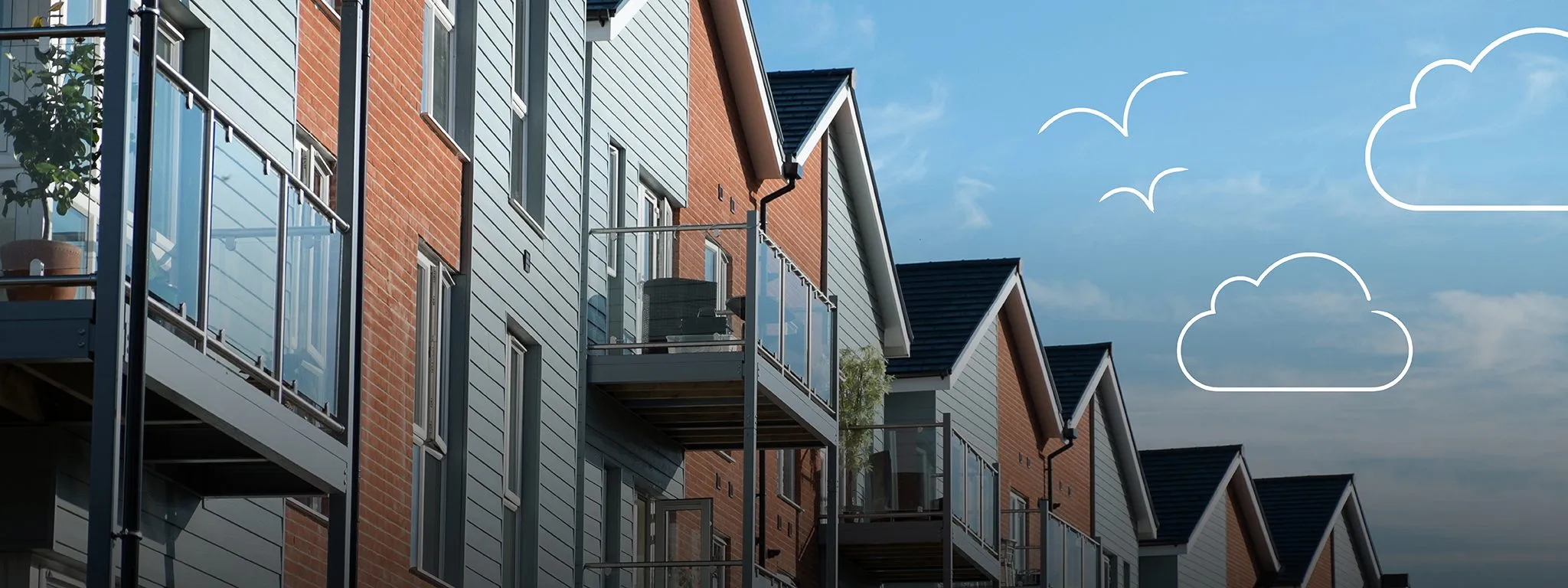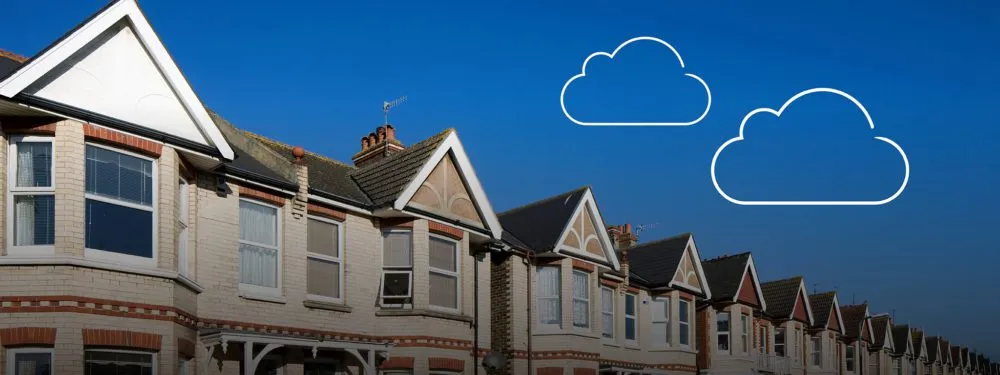Who is responsible for arranging block of flats insurance?
The responsibility of block of flats insurance falls to the freeholder. This could be landlords, residents associations, or those property managers who own an entire apartment block, where individual flats are either owner occupied or rented out to tenants.
What does buildings insurance cover in a block of flats?
Buildings insurance is usually the essential policy that covers the physical structure of the property.
Insurers like to explain it as follows. If the block of flats was turned upside down, buildings insurance would cover any damaged walls and fixtures and this would therefore be the responsibility of whoever owns the building. Anything “loose” that fell out would be considered part of a separate contents policy and likely to be the responsibility of the tenant or flat owner.
Read more about whether you need landlord building insurance, contents insurance or both.
How easy is it to arrange block of flats insurance?
A block of flats insurance policy is a form of landlord insurance that takes account of these additional risks posed by multiple leasehold properties in one block.
As the freeholder/landlord of a block of flats, or a representative of a property management company, then it’s your responsibility to insure your block.
And you’ll know only too well that there is likely to be multiple properties within the same building, communal areas, and different types of occupants to consider when arranging a policy.
Buildings insurance for a block of flats may seem like a large undertaking – but by connecting with a specialist insurance broker like Protect My Let, it’s a pain-free process
At Protect My Let, we’ve more than 30 years of experience helping landlords like you find better cover for your rental properties. That’s a lot of fully insured blocks of flats since 2004.
And each policy and insurance situation is personal to us. There’s no hard sell, just real people having a real conversation so we can find you exclusive deals on your landlord buildings, landlord-owned contents, and liability insurance.
What else do I need to know about arranging block of flats insurance?
No two blocks of flats are the same and at Protect My Let we understand that. As such, there are quite a few questions we need to ask to get you the right cover. For some of the more obscure and unusual ones, you may want to prepare in advance so when you talk to us about arranging block of flats insurance, you’re ready to go:
Rebuild cost
The rebuild cost of your block of flats is the amount required to rebuild the property, based on materials and labour.
This is different from the market value of the property, and neither is it the popular but often inaccurate methods of working out rebuild value based on taking the market value and subtracting a percentage.
On that topic, to demonstrate why this is not reliable; market values are mainly driven by postcode, while material and labour costs do vary based on location but not to the same extent. So, a house in London shouldn’t cost much more to build than a house in Wales, but the market values for the same property will probably be vastly different.
We recommend that to get an accurate idea of your rebuild cost, you get a proper survey done or use an online calculator, such as the one provided by the Royal Institute of Chartered Surveyors (RICS).
Read more about multiple properties and underinsurance.
Block insurance occupancy
Your insurer is likely to ask questions about the occupancy of the block of flats you own.
Make sure you answer everything fully and truthfully, so they calculate the right buildings insurance premium for your residents.
Students will be seen as a higher risk type of tenant, presenting more chance of a claim for damage, rather than a long-term let to a working professional.
Bearing in mind all of the above, any type of tenant should present a lower risk than that of an unoccupied flat.
Block insurance claims history
If you have any claims on home insurance within the last few years then these will need to be declared when an insurer when asks about this. This includes providing the date of the claim, total cost, and details about the incident.
With block of flats insurance and if you’re the freeholder, this should be relatively easy – you should have the paperwork/ But if you have co-freeholders who you’re speaking on behalf of, or have bought out any other freeholders, you may need to check with them to confirm if they have any previous claims.
Date of construction
Most insurers use bands to determine the risk of a property based on age. That means you may not need to give an exact date as long as you’re accurate to within a few years.
We’d still advise you to find out exactly when the block of flats was built by looking at your purchase documentation, land registry records, or even asking neighbours in adjacent and similar buildings.
You’re also likely to be asked by the insurer whether the block of flats is listed, as this also affects risk. If there’s any damage that needs to be addressed, listed properties are required by law to be restored using authentic materials and methods – which can be much more costly than a standard property.
Joint freeholders
If you’re the only freeholder then you’ll only need to give your own details as policyholder. A management company you’re authorised to act for can make the process of getting insurance faster if the freehold is shared. However, if you don’t have a company and the freehold is shared then you’re likely to need their details as well, such as the other freeholder’s date of birth and any claims history.
Multi-property insurance/landlord portfolio insurance
If you own more than one property such as several blocks of flats, then it’s worth exploring if you can get better value by arranging buildings insurance for all your properties at the same time.
Not only are insurers willing to compete more for bigger customers but this can save a lot of admin and bureaucracy by keeping all your properties on the same policy renewed every year – and all under one roof.
What should I consider when buying block of flats insurance?
What to look for
When buying a policy for buildings insurance – especially block of flats insurance – there are a few key aspects to look out for, and a number of things that may not be covered.
Exclusions
You can often determine the quality of an insurance policy by how easy it is to make a claim. But like any other insurance product, don’t assume the cheapest policy is right for you as these may come with prohibitive exclusions or high excesses (see below).
Exclusions are boundaries insurers set within an insurance policy that an insurer will not pay out for.
However, exclusions can sometimes be helpful if you’re working with a specialist insurer. For instance, if you live in a high-flood-risk area or your block of flats has a previous claim for subsidence, you may find insurers either won’t cover you or will inflict a very high premium unless that particular high-risk peril is excluded. In this case, forewarned is forearmed.
Nevertheless, this still affects the overall value of the policy to protect you, so try to find an insurer with fewer exclusions.
Excesses
The excess is the mandatory contribution you pay towards any claims. For example, a £10,000 flood claim might require you to pay the first £500 depending on your policy wording.
A higher excess will often mean a cheaper premium but will make claims more expensive. You may find it’s not even worthwhile to claim for smaller damages if you have a higher excess.
But a good insurer should be willing to work with you and provide a range of excesses and prices to suit you and the requirements of your property.
Bear in mind that different types of claim may have their own excesses and these should be defined in your policy wording. For instance, subsidence claims tend to carry a significantly higher excess than other types of claim.
Premium
Different insurers often present different prices for the same policy. This is a natural side effect of a market competing for your business. You may have a smaller market of providers than you’re used to for buying a specific policy such as block of flats insurance, but there should still be enough choice and variety of quotes to compare and contrast before deciding.
Customer service
The impression an insurer leaves and how they present themselves at the policy-buying stage often says a lot about the service and treatment you’re likely to receive when you have to claim make a claim.
So, when deciding on the best solution for your block of flats cover, align yourself with an insurer and broker that actively invests in every relationship with its customers. That means personal, knowledgeable service (real people, not chatbots) from initial questions, to sale, through to ongoing support and – should you ever require it – claims handling.
While Protect My Let is proud to offer all of that, don’t forget to check out the genuine customer feedback on sites like Feefo, Trustpilot, or even Facebook. Everyone and every business makes mistakes, but it’s how a company responds to a negative review or fixes the problem that is the real test.
Why do I need specialist block of flats insurance?
Even once all of the above questions have been answered, this is still a common query.
If the block is a converted house with just a couple of flats for rent within, don’t be tempted to go for standard home insurance. Your insurer needs to know about the occupancy of the flats, whether that’s four tenants or 140.
And as previously stated, unoccupied flats usually pose the highest risk of expensive claims because dangers like leaks may go unnoticed while lots of damage is done. The risk of burglary is also higher.
There are also all those different types of tenants from high-claims-risk students to lower risk professionals or retirees.
While different types of property and occupancy can seem daunting – especially for those new to multiple –occupancy, as long as you’re clear and transparent with your insurer about occupancy and disclosure, you’ll be offered the right cover for you at the right price.
And of course, one definitely doesn’t fit all with something like block of flats insurance, so engage with a specialist broker like Protect My Let. That way you can be certain of getting the best insurance for you, your properties, and your tenants.

















